Best Plants for Bedroom
- January 5, 2024
- 0 comment
Crafting a serene and restful atmosphere in your bedroom is crucial given the substantial amount of time spent in this space. To achieve this, consider incorporating indoor plants as a simple and cost-effective means of transforming your bedroom into a tranquil sanctuary. These plants not only enhance the visual appeal of your room but also contribute to your overall well-being, positively influencing your health, mood, and quality of sleep.
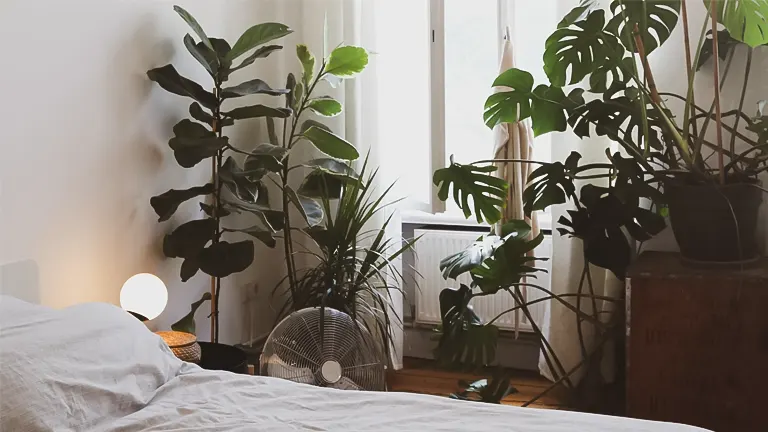
Based on NASA research, numerous popular houseplants have demonstrated the ability to purify the air by filtering out toxins and emitting oxygen throughout the night. Additionally, specific plant varieties offer allergy relief and stress reduction. Elevating the aesthetics of your bedroom becomes effortlessly achievable with a diverse range of plants, from expansive indoor trees to petite succulents.
The selection featured is designed to be beginner-friendly, thriving in low-light conditions and requiring minimal maintenance. Whether you desire a plant that flourishes with attentive care or a hanging variety that injects personality into your space, there is undoubtedly a suitable option to complement your bedroom style. Ensure to enhance the presentation of your chosen plants with the best indoor pots or planters. For further inspiration on incorporating greenery into your living spaces, explore our guides on the best kitchen plants and the optimal choices for bathroom plants.
Best Plants for Bedroom List:
- Snake Plant
- Calathea Plant
- Philodendron Plant
- Money Tree
- Ficus Tineke Plant
- English Ivy Plant
- Peace Lily Plant
- Spider Plant
- Jasmine Plant
| Plant | Light Requirements | Watering Needs | Care Difficulty | Air Purification | Toxicity | Common Issues |
|---|---|---|---|---|---|---|
| Snake Plant | Low to Moderate | Low | Easy | Excellent | Mild | Overwatering, root rot |
| Calathea Plant | Medium to High | Moderate | Moderate | Moderate | Non-toxic | Brown leaf edges, pests |
| Philodendron Plant | Low to Moderate | Moderate | Easy | Good | Mild | Overwatering, pests |
| Money Tree | High | Moderate | Easy | Good | Non-toxic | Overwatering, pests |
| Ficus Tineke Plant | Medium to High | Moderate | Moderate | Good | Mild | Leaf drop, pests |
| English Ivy Plant | Low to High | Moderate | Easy | Good | Mild | Spider mites, pests |
| Peace Lily Plant | Low to Medium | Moderate | Easy | Excellent | Mild | Brown tips, overwatering |
| Spider Plant | Low to Moderate | Moderate | Easy | Excellent | Non-toxic | Brown tips, pests |
| Jasmine Plant | High | Moderate | Moderate | Moderate | Non-toxic | Yellow leaves, pests |
1. Snake Plant
Snake plants, commonly recognized as beginner-friendly succulents, have gained popularity for their ease of cultivation. According to Paris Lalicata, a plant expert at The Sill, these versatile plants thrive in various lighting conditions, ranging from low, indirect light to afternoon direct sun.
Managing their care is straightforward; allowing the soil to completely dry out before watering, typically every one to two weeks in the spring and summer, and extending to every two to three weeks in the fall and winter.
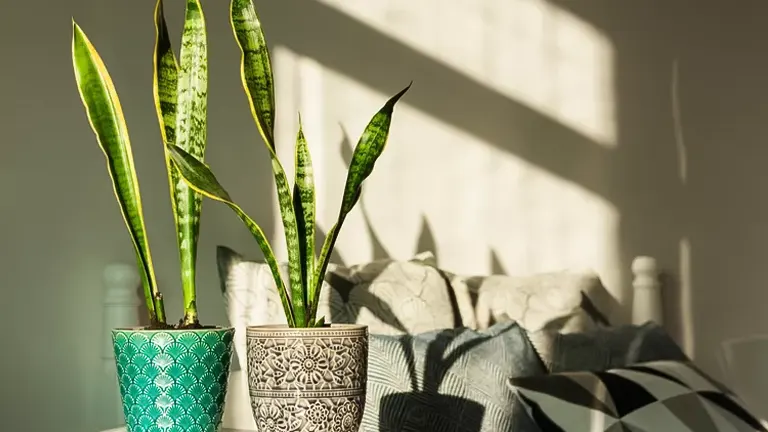
The added allure of snake plants lies in their unique ability to convert carbon dioxide into oxygen at night, a feature uncommon among most houseplants that typically perform this function during the day. This exceptional quality positions them as an excellent choice for a bedside companion, contributing not only to a visually appealing space but also enhancing the air quality for a restful night’s sleep.
Pros of Snake Plant
- Low Maintenance: Snake plants are easy to care for, thriving in various lighting conditions and requiring infrequent watering.
- Air Purification: They convert carbon dioxide into oxygen, contributing to improved indoor air quality, especially at night.
- Versatility in Lighting: Adaptable to different light levels, making them suitable for various indoor spaces.
- Aesthetic Appeal: With sleek, upright leaves and distinctive patterns, snake plants enhance the visual appeal of any room.
Cons of Snake Plant
- Sensitive to Overwatering: Prone to root rot if overwatered, requiring a careful and balanced watering routine.
- Limited Growth: Slow growth rate may not appeal to those seeking rapid greenery expansion.
- Potential for Pests: Susceptible to pests like spider mites and mealybugs, necessitating regular inspection and preventive measures.
- Toxicity: Contains compounds that can be harmful if ingested, requiring caution in homes with pets or small children.
2. Calathea Plant
The distinctive and vibrantly patterned foliage of calathea plants presents an excellent opportunity to elevate the aesthetic appeal of your bedroom decor. According to Lalicata, this particular species goes beyond mere visual charm; it also serves as an intuitive bedtime companion. The calathea exhibits nyctinasty movement, a fascinating behavior where it raises its leaves at night and lowers them during the day in synchronization with its circadian rhythm, optimizing light absorption.
To ensure the flourishing of calatheas in your bedroom oasis, it’s essential to consider their lighting preferences. While they thrive in medium to bright indirect light, they also showcase adaptability by tolerating low indirect light conditions. Given their affinity for moisture, a thoughtful watering routine is crucial.
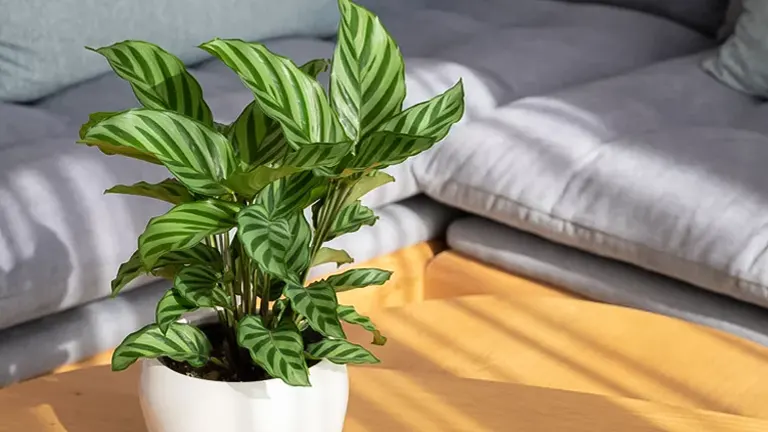
Ideally, water the calathea when approximately half of the soil has dried out, adjusting the frequency to about once a week in the spring and summer or extending to every 10-14 days in the fall and winter, depending on the prevailing environmental conditions. This detailed care approach ensures that the captivating calathea not only enhances your sleep environment with its visual allure but also thrives in optimal conditions, becoming a delightful and resilient addition to your bedroom decor.
Pros of Calathea Plant
- Aesthetic Appeal: Calathea plants boast uniquely patterned and colorful foliage, serving as a visually captivating addition to bedroom decor.
- Intuitive Bedtime Companion: The nyctinasty movement of calatheas, where they raise their leaves at night and lower them during the day, aligns with a circadian rhythm, making them a charming and natural indicator of bedtime.
- Adaptable Lighting Preferences: Thriving in medium to bright indirect light, calatheas also exhibit tolerance for low indirect light, providing flexibility in placement within indoor spaces.
- Moisture-Loving Resilience: Calatheas, known for their affinity for moisture, can be effectively cared for with a thoughtful watering routine, enhancing their resilience and overall health.
Cons of Calathea Plant
- High Maintenance: Calatheas require consistent care, including monitoring lighting conditions and adhering to specific watering routines, making them less suitable for those seeking low-maintenance plants.
- Sensitive to Drafts: These plants can be sensitive to drafts, requiring placement in areas with stable temperatures to prevent stress and potential health issues.
- Prone to Browning Edges: Calatheas may develop brown edges on their leaves if environmental conditions, such as humidity levels, are not adequately maintained.
- Moderate Light Dependency: While adaptable, calatheas still depend on adequate light for optimal growth, and insufficient light may impact their vibrant foliage patterns.
3. Philodendron Plant
Philodendrons, distinguished by their stunning heart-shaped leaves and rapidly growing trailing vines, have the transformative power to turn any bedroom into a verdant oasis reminiscent of a lush jungle. For optimal growth, it is advisable to position or hang these plants near a window where they can bask in medium-bright indirect light, fostering their lush and vibrant appearance.
According to insights from Lalicata, the key to philodendron care lies in allowing the soil to dry out between waterings. Striking a balance is crucial, typically requiring watering every seven to 10 days, depending on the environmental conditions within the home.
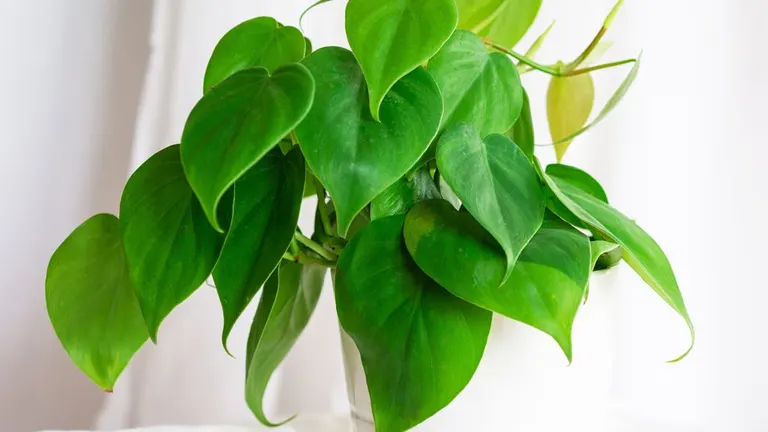
Interestingly, philodendrons exhibit a unique communication method when they are in need of water – the leaves will visibly droop and curl inwards, signaling a clear indicator for caregivers. This detailed care approach ensures not only the aesthetic enhancement of the bedroom with the captivating foliage of philodendrons but also the sustained health and vitality of these botanical companions.
Pros of Philodendron Plant
- Aesthetic Appeal: Philodendrons feature beautiful heart-shaped leaves and quick-growing trailing vines, adding a lush and jungle-like ambiance to any bedroom.
- Rapid Growth: Known for their quick growth, philodendrons can swiftly transform spaces, providing a visually dynamic element to interior decor.
- Adaptability to Light: Thriving in medium-bright indirect light, philodendrons showcase adaptability, making them versatile for placement in various indoor environments.
- Visual Indicators for Watering: Philodendrons display visible cues, such as drooping and curling leaves, signaling the need for water, making it easier for caregivers to gauge their hydration needs.
Cons of Philodendron Plant
- Moderate Maintenance: Philodendrons require a moderate level of maintenance, including monitoring light exposure and adhering to specific watering intervals, making them less suitable for those seeking low-maintenance plants.
- Sensitive to Overwatering: Like many houseplants, philodendrons are sensitive to overwatering, and care must be taken to allow the soil to dry out between waterings to prevent root-related issues.
- Space Consideration: Due to their rapid growth and trailing vines, philodendrons may require sufficient space or regular pruning to prevent overcrowding and maintain their desired aesthetic.
- Potential for Allergies: Some individuals may be sensitive to the sap of philodendrons, causing skin irritation, so it’s essential to handle them with care.
4. Money Tree
The money tree is renowned for its ability to attract good luck and fortune, making it an ideal addition to the bedroom for fostering positive Feng Shui. Its distinctive braided trunk, along with its resilience and straightforward cultivation, contribute to its popularity. To ensure optimal growth, it is important to provide the money tree with sufficient sunlight, as it is not tolerant of low light.
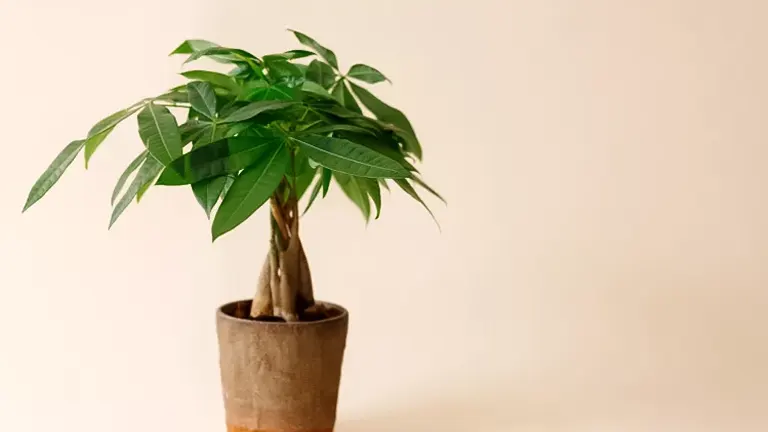
The plant thrives in medium-bright indirect light with occasional dappled direct sun exposure. According to Lalicata’s advice, monitoring the soil moisture is crucial for proper care. It is recommended to water the money tree only when the soil has nearly or completely dried out.
In brighter conditions, this may occur approximately every seven to 10 days, while in shadier environments, a watering schedule of every 10-14 days is advisable. By following these guidelines, one can nurture a thriving money tree and enhance the positive energy within the bedroom.
Pros of Money Tree
- Symbol of Prosperity: The money tree is associated with good luck and financial prosperity, making it a popular choice for those seeking positive energy and abundance.
- Resilient and Easy to Grow: Known for its resilience, the money tree is a low-maintenance plant, making it suitable for both novice and experienced plant enthusiasts.
- Attractive Appearance: The unique braided trunk and vibrant green leaves contribute to the money tree’s aesthetic appeal, adding a touch of natural beauty to indoor spaces.
- Feng Shui Benefits: Placing a money tree in the bedroom is believed to enhance Feng Shui, creating a harmonious and positive atmosphere that may positively impact various aspects of life.
Cons of Money Tree
- Light Sensitivity: The money tree requires sufficient sunlight, and its sensitivity to low light conditions may pose a challenge for those with limited access to natural light in their living spaces.
- Watering Requirements: Careful monitoring of soil moisture is essential, as overwatering or underwatering can lead to issues such as root rot or leaf yellowing.
- Toxicity Concerns: While generally non-toxic, the money tree’s sap may cause mild irritation in some individuals or pets if ingested, so it’s important to keep it out of reach.
- Space Consideration: As the money tree grows, it may require more space, potentially becoming a concern for those with limited room for larger plants.
5. Ficus Tineke Plant
This effortlessly cared-for plant boasts captivating leaves in vibrant shades of pink, green, and yellow, introducing a burst of color and dimension to the bedroom. According to Lalicata, if your bedroom receives abundant sunlight, this plant can flourish and reach heights exceeding 5 feet as it matures, evolving into an impressive statement piece.

Similar to money trees, ficus plants do not fare well in low-light conditions, necessitating a bright environment for optimal growth. To ensure thriving conditions, Lalicata advises a cautious approach to watering only when the soil has nearly or completely dried out. This meticulous care routine contributes to the ficus’s overall health and enhances its potential to become a stunning and visually dynamic addition to your bedroom decor.
Pros of Ficus Tineke Plant
- Aesthetic Appeal: The Ficus Tineke plant is prized for its visually striking pink, green, and yellow leaves, adding a vibrant and captivating touch to indoor spaces.
- Statement Plant Potential: With the ability to grow well over 5 feet in height, the Ficus Tineke has the potential to become an impressive statement plant, enhancing the overall aesthetics of the room.
- Adaptable to Sunlight: Thriving in ample sunlight, this plant is adaptable to bright environments, making it a suitable choice for rooms with good natural light.
- Low Maintenance: Similar to other ficus varieties, the Ficus Tineke is known for its low-maintenance nature, making it a convenient option for individuals who prefer plants that require minimal care.
Cons of Ficus Tineke Plant
- Light Sensitivity: Like many ficus plants, the Ficus Tineke does not tolerate low light well, requiring bright light conditions for optimal growth, which may be a limitation in spaces with limited sunlight.
- Watering Caution: To prevent overwatering, it’s crucial to follow a careful watering schedule, allowing the soil to almost or completely dry out before adding more water.
- Potential Size Concerns: While the plant’s ability to grow tall is a pro for some, it may pose a challenge for those with limited space, as the Ficus Tineke can become quite large over time.
- Specific Care Requirements: The Ficus Tineke, like other ficus varieties, may have specific care needs, and failure to meet these requirements could lead to issues such as leaf drop or diminished vibrancy.
6. English Ivy Plant
This particular plant, tailor-made for hanging baskets, emerges as an exquisite enhancement for the tranquil setting of your bedroom. Lindsay Hall, a distinguished botanist and authoritative contributor to the gardening blog Positive Bloom, extols the virtues of this verdant gem.
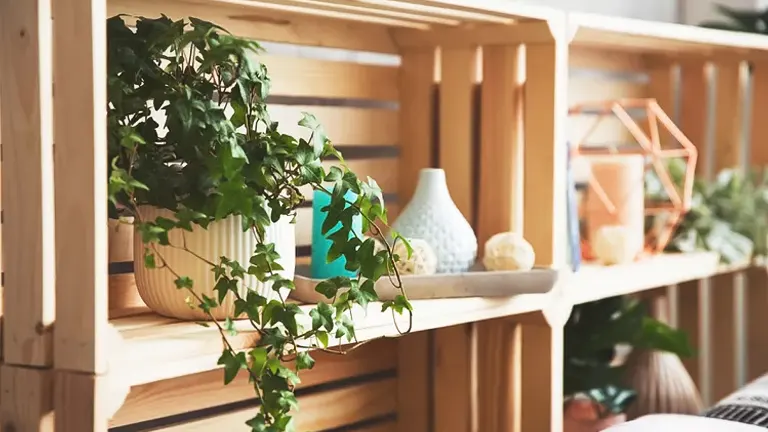
Its rapid growth is complemented by an undemanding nature, thriving with minimal intervention. The key to its prosperity lies in its accommodation within a free-draining soil environment, exposure to bright indirect light, and a judicious watering routine, triggered when the top 2 inches of the soil exhibit dryness.
Hall’s botanical wisdom encapsulates the plant’s ease of cultivation, making it an ideal choice for those seeking an effortlessly vibrant addition to their indoor plant collection, a testament to nature’s grace within the confines of your living space.
Pros of English Ivy Plant
- Air Purification: English Ivy (Hedera helix) is known for its air-purifying qualities, effectively removing pollutants from the indoor environment.
- Versatile Growth: It adapts well to various conditions, thriving both indoors and outdoors, making it a versatile choice for different settings.
- Aesthetic Appeal: With its cascading vines and lush foliage, English Ivy adds an elegant and aesthetic touch to any space, serving as a decorative element.
- Low Maintenance: Generally, English Ivy is low-maintenance, requiring minimal care once established, making it suitable for those who prefer hassle-free plants.
Cons of English Ivy Plant
- Invasiveness: When planted outdoors, English Ivy can become invasive, spreading rapidly and potentially outcompeting native vegetation.
- Toxicity: The plant is toxic if ingested, posing a risk to pets and humans, so caution is necessary, especially in households with curious animals or small children.
- Susceptibility to Pests: English Ivy can attract certain pests like spider mites and aphids, requiring vigilance and potential pest control measures.
- Indoor Allergen: For some individuals, the fine hairs on English Ivy leaves may trigger allergies, so it might not be the best choice for those with sensitivities.
7. Peace Lily Plant
The Peace Lily boasts exquisite foliage and elegant white blossoms, rendering it a delightful and soothing addition to any bedroom. In addition to its aesthetic appeal, this plant offers the practical benefit of increasing indoor humidity, making it particularly advantageous for individuals dealing with dry nasal passages. Despite being generally considered an easy-to-maintain plant, it requires careful attention to specific care guidelines.
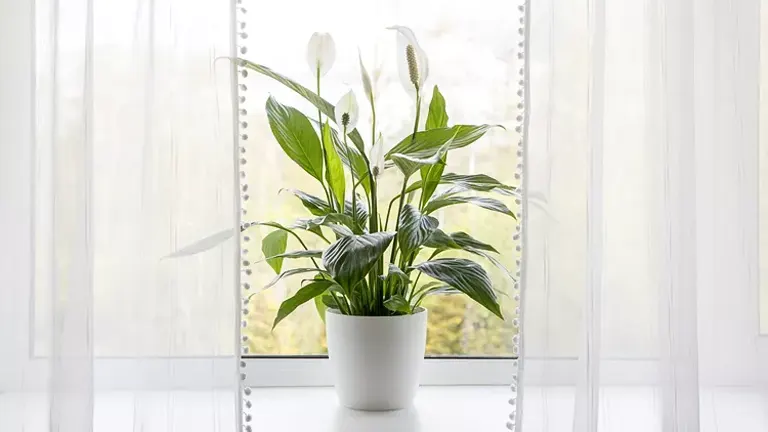
To ensure optimal growth, it is crucial to shield the Peace Lily from direct sunlight, as it is highly sensitive to it. Instead, it thrives in bright yet indirect light conditions. Planting it in a well-draining growing medium is essential to prevent waterlogging.
During the growing season, monthly feeding with a diluted all-purpose houseplant fertilizer is recommended to provide the necessary nutrients. Moreover, regular watering should be undertaken, ensuring that the upper layer of the soil has dried out before the next watering session. Adhering to these care instructions will help foster the well-being and longevity of your Peace Lily.
Pros of Peace Lily Plant
- Aesthetic Beauty: Peace Lilies are renowned for their elegant white flowers and lush, attractive foliage, adding a touch of beauty to indoor spaces.
- Air Purification: These plants excel at purifying indoor air by removing pollutants like formaldehyde, benzene, and ammonia, contributing to a healthier living environment.
- Humidity Regulation: Peace Lilies naturally increase indoor humidity levels, benefiting individuals with dry nasal passages and creating a more comfortable atmosphere.
- Low Maintenance: Generally considered easy to care for, Peace Lilies thrive in low to medium light conditions and require minimal attention, making them suitable for busy or novice plant owners.
Cons of Peace Lily
- Toxicity: While appealing, Peace Lilies contain calcium oxalate crystals, which can be toxic if ingested. Caution is advised, especially in households with pets or small children.
- Sensitive to Light: Peace Lilies are sensitive to direct sunlight and can suffer if exposed to harsh rays. Careful placement in bright but indirect light is crucial for their well-being.
- Overwatering Risk: Despite their need for regular watering, overwatering can lead to root rot. It’s essential to let the top layer of soil dry out before the next watering session.
- Limited Flowering in Low Light: In low-light conditions, Peace Lilies may not bloom as prolifically, reducing their aesthetic appeal. Adequate lighting is essential for consistent flowering.
8. Spider Plant
Similar to snake plants, spider plants are beneficial nighttime companions as they release oxygen during the night, contributing to improved air quality. Apart from their functional attributes, spider plants also stand out visually with their variegated foliage and gracefully cascading leaves.

To ensure the well-being of your spider plant, it is important to provide suitable care. Position it in an area with low to bright indirect light, avoiding direct sunlight. The soil should be well-draining to prevent waterlogging and maintain optimal root health. A key care guideline is to water the spider plant when the top 2 inches of the soil have dried out. Adhering to these recommendations will promote the vitality and aesthetic appeal of your spider plant.
Pros of Spider Plant
- Air Purification: Spider plants are excellent air purifiers, removing pollutants like formaldehyde and benzene, contributing to a healthier indoor environment.
- Low Maintenance: Well-suited for beginners, spider plants are resilient and require minimal care. They can thrive in various light conditions and tolerate occasional neglect.
- Adaptability: Spider plants are adaptable to different environments and can be grown in hanging baskets, pots, or as ground cover, providing flexibility in home decor.
- Propagation: These plants produce offshoots called “pups” that can be easily propagated, allowing for the expansion of your plant collection or sharing with others.
Cons of Spider Plant
- Sensitive to Chlorine: Spider plants can be sensitive to chlorine in water. Using filtered or distilled water is advisable to prevent leaf burn and maintain their health.
- Brown Tips: While generally hardy, spider plants may develop brown tips if exposed to dry air or fluctuations in watering. Adequate humidity and consistent watering can help mitigate this issue.
- Susceptible to Spider Mites: Despite the name, spider plants can attract spider mites. Regularly inspecting the leaves and treating any infestations promptly is crucial.
- Non-Edible: Spider plants are not suitable for consumption, and ingesting any part of the plant may cause mild stomach upset in pets or humans. Keep them out of reach of curious pets and children.
9. Gardenia Plant
For those who possess a green thumb and seek to elevate their bedroom’s ambiance, the inclusion of a flowering plant with fragrant blossoms, such as the gardenia, can be a captivating choice. However, it’s important to note that the gardenia may not be the most beginner-friendly option due to its demanding care requirements, as highlighted by Hall.
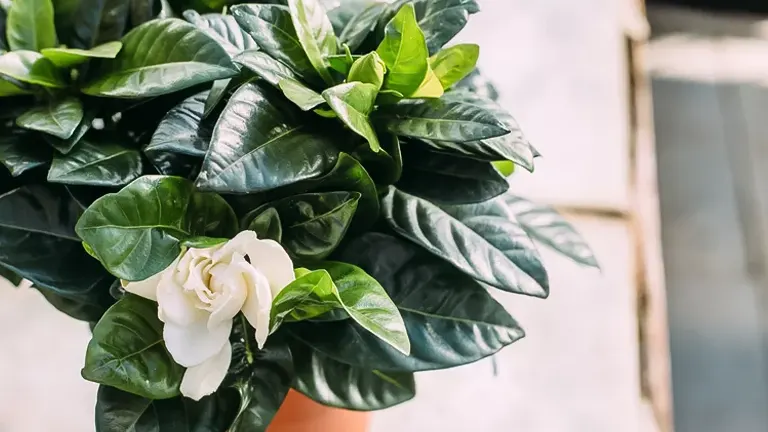
The gardenia is known for producing enchanting white blossoms, but its cultivation necessitates careful attention. To cultivate this plant successfully, it is essential to address specific care considerations. This includes planting it in a well-draining, nutrient-rich, and acidic soil, creating an environment conducive to its growth. Furthermore, maintaining bright yet indirect light, coupled with a humidity level of at least 60 percent, is crucial for the gardenia’s well-being.
Taking on the challenge of nurturing a gardenia also involves a seasonal approach to care. Hall recommends fertilizing the plant twice at the onset of the growing season to provide essential nutrients. Additionally, a consistent watering routine is advised, ensuring that the topsoil is allowed to dry out between watering sessions. By adhering to these detailed care instructions, individuals with a penchant for gardening challenges can enjoy the beauty and fragrance of gardenia blossoms in their bedroom.
Pros of Gardenia Plant
- Fragrant Blossoms: Gardenia plants are prized for their captivating and fragrant white blossoms, adding a delightful and aromatic touch to indoor or outdoor spaces.
- Aesthetic Appeal: With glossy green foliage and elegant blooms, gardenias contribute to a visually appealing garden or interior decor, enhancing the overall aesthetic.
- Seasonal Blooms: Gardenias typically produce blooms during specific seasons, providing bursts of color and fragrance that can be enjoyed at specific times of the year.
- Versatility: While often grown outdoors, gardenias can also thrive in containers, allowing individuals with limited garden space to enjoy these beautiful plants on balconies or patios.
Cons of Gardenia Plant
- High Care Requirements: Gardenias demand meticulous care, making them challenging for beginners. Specific needs include well-draining, nutrient-rich, and acidic soil, along with bright, indirect light and high humidity.
- Prone to Diseases: Gardenias are susceptible to various diseases, including fungal infections and pests. Regular monitoring and prompt treatment are essential to maintain their health.
- Sensitive to Environmental Changes: Gardenias can be sensitive to changes in temperature, humidity, and light conditions. Sudden fluctuations may lead to stress and affect their overall well-being.
- Limited Cold Tolerance: Most gardenia varieties are not cold-hardy, and exposure to frost or chilly temperatures can damage the plant. Protective measures may be necessary in colder climates.
10. Jasmine Plant
For those grappling with anxiety and insomnia, incorporating jasmine into your bedroom can prove highly beneficial. This plant is renowned for its sweet and soothing fragrance, which exerts a calming influence, aiding in stress reduction and promoting a conducive environment for restful sleep. Additionally, beyond its aromatic qualities, the jasmine plant also offers visual appeal.
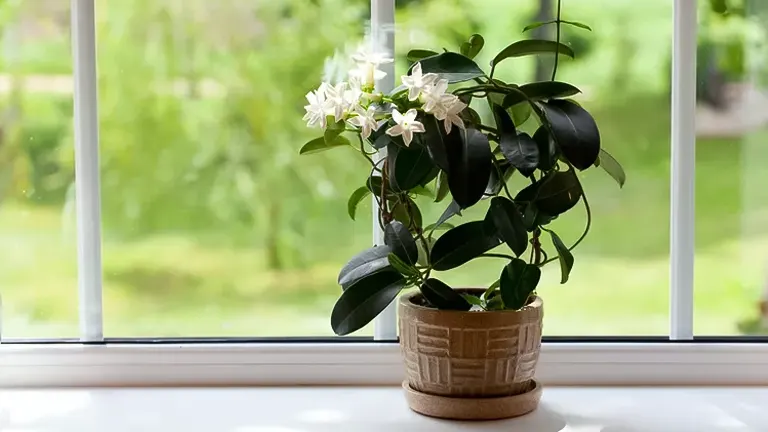
Detailed care instructions for jasmine involve maintaining a consistently moist soil, given its affinity for water. However, a cautious approach is advised to prevent overwatering, striking a balance that ensures the plant’s hydration needs are met without causing waterlogged conditions. Optimal placement for jasmine is near a south-facing window, where it can receive ample sunlight.
In cases where south-facing windows are unavailable, alternative locations on the windowsills of west- or east-facing windows are suitable. By adhering to these specific care guidelines, individuals can cultivate a thriving jasmine plant that not only enhances the aesthetic charm of their bedroom but also contributes to a tranquil and anxiety-reducing atmosphere.
Pros of Jasmine Plant
- Calming Fragrance: Jasmine plants emit a sweet and soothing fragrance known to have calming effects, making them an excellent choice for promoting relaxation and reducing stress.
- Aesthetic Appeal: With lush green foliage and delicate, aromatic flowers, jasmine plants add visual charm to indoor or outdoor spaces, enhancing the overall aesthetic of gardens and interiors.
- Adaptability: Jasmine plants are versatile and can thrive both indoors and outdoors, offering flexibility in placement. They can be grown in containers, hanging baskets, or as ground cover.
- Attracts Pollinators: Jasmine flowers attract pollinators such as bees and butterflies, contributing to a healthier garden ecosystem.
Cons of Jasmine Plant
- Moisture Requirements: Jasmine plants are water-loving and require consistently moist soil. However, overwatering can lead to root rot, emphasizing the need for careful monitoring of soil moisture.
- Sensitive to Cold: Some jasmine varieties are sensitive to cold temperatures and may require protection during winter. In colder climates, they may need to be grown in containers and brought indoors during winter months.
- Potential Invasiveness: Certain jasmine species can be invasive in certain regions, spreading rapidly and outcompeting native plants. Local regulations should be considered before planting certain varieties.
- Pruning Needs: Regular pruning is necessary to maintain the shape and size of jasmine plants. Without proper pruning, they can become unruly and overgrown.
Final Conclusion
When selecting plants for the bedroom, it’s essential to consider not only aesthetic appeal but also their air-purifying qualities and adaptability to low-light conditions, common in bedrooms. The Snake Plant and Spider Plant emerge as top choices due to their low maintenance, air-purifying capabilities, and suitability for low-light environments. Snake Plants, with their upright sword-like leaves, thrive in low light, require minimal water, and excel at removing toxins. Spider Plants, recognized for their arching leaves and spiderettes, are resilient, thrive in indirect light, and contribute significantly to air purification. Both plants not only enhance the bedroom’s visual appeal but also promote a healthier indoor environment, making them ideal choices for creating a tranquil and revitalizing atmosphere in the bedroom.
Frequently Asked Questions
- What makes a plant suitable for a bedroom?
Bedroom-friendly plants are often those that thrive in low-light conditions, require minimal maintenance, and contribute to improved air quality, promoting a peaceful and healthy sleeping environment. - Which plants are best for low-light bedrooms?
Snake Plants, ZZ Plants, and Peace Lilies are excellent choices for low-light bedrooms, as they can tolerate and even thrive in indirect sunlight. - Do bedroom plants improve air quality?
Yes, many bedroom plants, such as Snake Plants, Spider Plants, and Peace Lilies, are known for their air-purifying abilities, helping to reduce indoor pollutants and enhance overall air quality. - How often should I water bedroom plants?
The watering frequency depends on the specific plant, but generally, it’s advisable to allow the soil to dry out between waterings. Overwatering can lead to root rot, so it’s crucial to strike a balance. - Are there any bedroom plants that are pet-friendly?
Yes, plants like Spider Plants, Boston Ferns, and Areca Palms are considered pet-friendly and non-toxic to cats and dogs. However, it’s always wise to check the specific toxicity of each plant. - Can I keep flowering plants in the bedroom?
Yes, flowering plants like Jasmine or Peace Lilies are suitable for bedrooms. Their pleasant scents can contribute to a calming atmosphere, but ensure they receive adequate light for blooming. - Do bedroom plants help with sleep?
While plants may contribute to a calming ambiance, there’s limited scientific evidence that specific plants directly improve sleep. However, the overall benefits of a green and visually appealing bedroom environment can positively impact relaxation. - Can I keep succulents in the bedroom?
Succulents, like Aloe Vera or Snake Plants, can thrive in bedrooms as they are low-maintenance and tolerate low light. Just ensure they receive occasional sunlight and well-draining soil. - How do I prevent common issues like overwatering?
To prevent overwatering, it’s crucial to allow the soil to dry out between watering’s and use well-draining pots. Monitor the specific water needs of each plant and adjust your watering routine accordingly. - Are there any plants specifically recommended for Feng Shuai in the bedroom?
Yes, plants like the Snake Plant and Peace Lily are often recommended for Feng Shuai in the bedroom. They are believed to bring positive energy and harmony to the space.
We’d love to hear about your experiences with bedroom plants! Share your insights and thoughts on your favorite bedroom greenery in the comments section below. Your personal tips and experiences could be invaluable for others looking to create a serene and healthy atmosphere in their bedrooms!

Edward Smith
Forestry AuthorWoodworking is about more than crafting; it's a harmonious connection with nature, mastering tools, and preserving our environment. I'm here to share my knowledge and experiences with you, forging a future where we can embrace wood's beauty and utility while safeguarding our forests' health and diversity.













Leave your comment